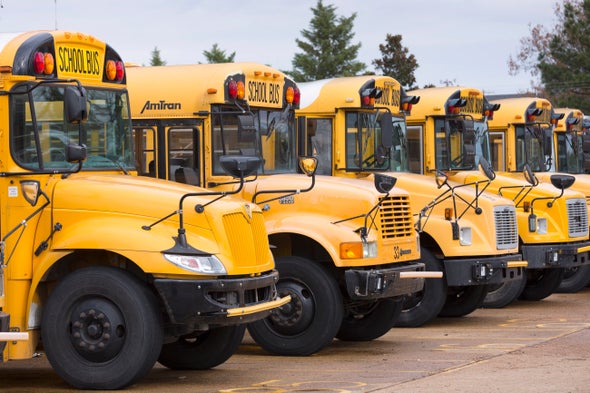- By Arianna Skibell, E&E News on July 30, 2021

Advocates worry that reduced funds will not go to the communities most in need.
Bobby Monacella was tired of sending her two kids to school on buses filled with diesel fumes. Pollution levels inside those iconic yellow buses can be up to 10 times higher than outside.
“They’re sitting on the bus for over an hour a day, and when you learn that the emissions are concentrated inside the bus, it’s scary,” said Monacella, who volunteers with the climate advocacy group Mothers out Front.
So she teamed up with other moms in Fairfax County, Va., to do something about it. The school district, which is the second largest in the country, agreed to replace its 1,650 diesel buses with electric ones by 2035.
But other families face longer waits.
The infrastructure package proposed by the Senate and the White House on Wednesday offers significantly less funding for electric school buses than what President Biden was seeking.
And without a federal infusion of cash and incentives, advocates fear zero-emissions school buses—which can cost three times more than those with internal-combustion engines—could be distributed unevenly, potentially leaving behind low-income families and students of color who already bear the brunt of environmental pollution.
“Those schools that can afford to make the transition and cover the costs of not just the school bus, but the charging infrastructure that’s needed, are in the predominantly wealthier communities,” said Trisha DelloIacono, the legislative manager for Moms Clean Air Force. “So federal investment is so needed.”
Electric school buses would receive $2.5 billion in funding under the package, enough for approximately 11,000 zero-emissions buses. Another $2.5 billion would go toward what lawmakers and the White House are calling low-emissions buses.
The lump sum is substantially less than the $174 billion Biden initially proposed last March to boost the overall EV market, including cars, trucks and buses. That plan aimed to electrify 96,000 school buses, or about 20% of the U.S. fleet.
“We need the full funding,” said Sybil Azur, a mom and community organizer who has been working to expand the use of electric school buses in Los Angeles. “What’s at stake is my children’s future, my children’s health and their ability to live productive, healthy lives.”
She and other advocates are concerned that the allocation for “low-emissions” school buses in the infrastructure package could prioritize other fuel types over electric technology.
“Essentially, this is a tiny drop in the bucket of what is needed to protect our children from harmful diesel pollution,” said DelloIacono. “To make matters worse, it won’t help our kids at all if it’s used for polluting fossil fuel buses under the guise of improving our nation’s infrastructure.”
There are 480,000 school buses across the country, 95% of which run on high-polluting diesel fuel. And more than half the nation’s public school students, about 25 million children, ride the bus to school and back each day.
Research conducted by Environment & Human Health Inc. has shown that pollution levels on those school buses often exceed surrounding areas by five to 10 times, endangering students’ health and contributing to greenhouse gas emissions. The transportation sector is the single largest source of carbon pollution in the country.
While scientists have long known that diesel pollution can cause a host of health problems, among them asthma and bronchitis, developmental disabilities, and cancer, recent research suggests the health impacts could be worse than previously thought.
A meta-analysis of hundreds of studies, published in 2018 in the American Journal of Public Health, found strong links between pollution exposure and cardiorespiratory diseases. Another study, issued by the National Bureau of Economic Research in 2018, found that air pollution significantly exacerbates dementia. Even a slight increase in air pollution from a single car can send more kids to the hospital and lead to premature births, according to a 2019 working paper from the Federal Reserve Bank of Chicago.
Environmental pollution is worse for children, whose brains are still developing, than for adults. And Black children are hospitalized from asthma twice as often as white children and are four times as likely to die from the disease. Latino children are also at higher risk.
That’s why Cinthia Moore, a mother and advocate living in a predominately Latino neighborhood in East Las Vegas, won’t let her son, Liam, ride the school bus.
“He has breathing issues,” she explained. “Whenever we have a bad air quality day, like today, if he spends any time outside, he comes back already with a runny nose and sneezing, and he also has rashes around his body because of the extreme heat.”
Monacella of Mothers out Front said the details around funding, and where charging infrastructure is placed, can determine whether electric school buses are distributed equitably.
She pointed to a Virginia pilot program in which Dominion Energy has deployed 50 electric school buses as part of broader vehicle-to-grid plan. Monacella said she worries that the utility may not prioritize low-income school districts.
“Dominion will help pay for some buses; maybe our state grant fund will help pay for some buses; and, you know, the more, the better,” she said. “But the way the Dominion program was set up, they wanted to own the batteries and the charging infrastructure, and they wanted to say where it could be sited. So it didn’t matter where the highest asthma rates were; it didn’t matter the lowest air quality. It just mattered what worked for them.”
A Dominion spokesperson said the utility has deployed its 50 electric school buses in geographically and economically diverse districts and intends to weigh equity concerns when expanding its vehicle-to-grid program.
“Every student in the commonwealth deserves access to a safe, emissions-free school transportation, and our goal is to help school districts make that transition,” spokesperson Samantha Moore wrote in an email.
As health impacts related to climate-fueled events like extreme heat or wildfires become more common among children, parents are increasingly calling on their elected officials to take action.
“If your child is struggling to breathe because of wildfire smoke due to climate change, to have the opportunity to put a child on an electric school bus and not be exposed to that additional pollution is critical for these families,” said DelloIacono of Moms Clean Air Force.
“And so they have really been at the forefront of advocating for this transition to electric school buses.”
Curbing emissions from school buses would eliminate as much as 5.3 million tons of greenhouse gas emissions each year. And while electric buses are currently more expensive to purchase than their diesel counterparts, schools could save hundreds of thousands of dollars on fuel and maintenance costs, according to a recent report led by the U.S. PIRG Education Fund.
“So a new infusion of federal funds is so important because it can really help with financing the upfront costs,” said John Stout, a transportation advocate with U.S. PIRG.
Despite funding hurdles, momentum for electric school buses is growing as the infrastructure debate intensifies on Capitol Hill.
Last year, a school district in Sacramento, Calif., became the owner of the largest electric school bus fleet in the country, with 40 zero-emissions buses. A county in Tennessee secured the state’s first all-electric school bus last month. In Maryland, Montgomery County Public Schools announced a contract earlier this year to replace all of its diesel buses with electric ones, starting with 326 buses over four years. The list goes on.
A recent poll from the American Lung Association found that 68 percent of American voters, across all major demographic groups, support Congress’ investing in zero-emission school buses nationwide.
This month, over 100 local school board officials across the country signed a letter to Biden and Congress calling for a $30 billion federal investment over 10 years to replace half the nation’s school bus fleet with electric buses.
Several lawmakers have introduced similar legislation. A recent measure from Reps. Tony Cárdenas (D-Calif.) and Jahana Hayes (D-Conn.) and from Sens. Alex Padilla (D-Calif.) and Raphael Warnock (D-Ga.) would authorize $25 billion to transition the nation’s school bus fleet over 10 years, giving priority to low-income and front-line communities.
Sen. Patty Murray (D-Wash.) also floated a bill earlier this year, which was originally introduced by former Sen. Kamala Harris in 2019, that would enable school districts to replace diesel buses with electric ones.
While many uncertainties remain—like how best to install charging infrastructure—Monacella said electrifying the nation’s school bus fleet is a crucial step not only to protect children’s health, but also to reduce carbon emissions. There are four times more school buses on the road than public transit buses.
“Climate change is happening all around us. It’s beyond crisis time,” she said. Electrifying school buses “is just one piece of the puzzle, but I think it can have a big impact, and it’s something I can do to try to make a difference.”
Reprinted from E&E News with permission from POLITICO, LLC. Copyright 2021. E&E News provides essential news for energy and environment professionals.
ABOUT THE AUTHOR(S)
Arianna Skibell covers transportation for E&E News.
